by Celeste Lipford and Terry Lipford - last updated on 10/2/2025
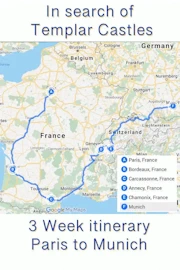
Our “day trip game plan” was simple: drive from Munich to Salzburg, a journey of roughly 159 kilometers along the A94 Autobahn. We were genuinely looking forward to experiencing the thrill of driving at autobahn speeds—something every road tripper dreams of—especially since large portions of the route are unrestricted. Of course, we knew speed limits apply near urban areas, but we still anticipated a swift and scenic ride. Unfortunately, fate had other ideas. A disturbance on the autobahn brought traffic to a crawl, turning our high-speed escape into a sluggish procession. What was meant to be a breezy drive became a tedious trek at an average of 20 mph, peppered with long pauses and creeping movement that tested our patience.
But the frustration melted away the moment we arrived in Salzburg.
The historic center, a UNESCO World Heritage Site, feels like walking through a living museum. Baroque buildings line the winding cobblestone streets, each corner revealing charming courtyards, wrought-iron signs, and elegant facades that seem unchanged by time. The mighty Hohensalzburg Fortress towers above it all, offering sweeping views of the city’s rooftops and the snow-capped Alps beyond. From the gentle sound of church bells to the echoes of Mozart’s compositions drifting from concert halls and open-air performances, Salzburg invites you to slow down and savor its beauty—whether you’re strolling through the Mirabell Gardens, sipping coffee in a centuries-old café, or simply watching the Salzach River flow by.
What began as a traffic-jammed journey turned into an unforgettable day in one of Europe’s most magical cities—a vivid reminder that sometimes, the detour makes the destination feel even more rewarding.
UNESCO Sites in Austria
Austria has 12 UNESCO World Heritage Sites, consisting of eleven cultural sites and one natural site. These sites include historic centers like Salzburg and Vienna, as well as cultural landscapes, palaces, ancient beech forests, and a railway. If you are interested in where these sites are take a look at our Austria UNESCO Sites page.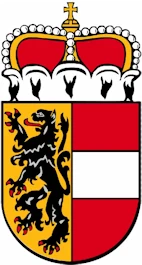
The Hallein Salt Mine (AKA the Salt Mine Durnberg) is an ancient underground salt mine located in the town of Hallein, Austria. It has been in operation for over 2,500 years and was one of the most important sources of salt in the region during the Middle Ages. Today, it is open to the public and offers an exciting glimpse into the history of salt mining.
Visitors can take a guided tour of the mine, which includes a train ride deep into the mountain and a walk through the underground chambers and tunnels. The tour also includes a visit to the miners' slide, a wooden slide used by the miners to quickly descend to lower levels of the mine.
The Salt Mine Dürrnberg is located only a few miles south of Salzburg, on the western side of the River Salzach, high up on a hill overlooking the river and just beyond the village of Hallein. To enter you are required to purchase tickets, and wear coveralls, in order to protect you (and your clothing) from all the salt and salt water found inside the salt mine.
Once everyone was suited up, we all walked to the mine entrance, and got onto a very small train, which then takes us into the mine.
After the mini train reaches as far as it can go, everyone dismounts and the walking tour of the mine commences. At one point, we actually crossed back into Germany, giving you an idea of how large this mine is.
As the mine is comprised of multiple levels, the access from level to level is via long wooden slides, which are polished to a high shine due to the incredible number of coverall wearing visitors who have slid down them!
Rolling along on the mini-train, headed to where the salt mine walking tour started. It was probably not quite a kilometer or two inside the mountain, but it was a rather fun way to cover that distance!
Mining is no longer performed there, as they have discovered that using water to percolate through the salt, produces a very briny fluid which is then left to dry, to produce high quality salt.
After our tour concluded, we drove back to Salzburg to visit the Hohensalzburg Festung, which sits high on a hill above the city. Salzburg is split down the middle by the River Salzach, with the "old city" on the side of the river nearest the Festung, and the "new city" on the other side. Wolfgang Amadeus Mozart was born in Salzburg in the 18th century, and the movie "Sound of Music" was filmed in and around this city.
The fortress was originally designed as a stronghold to protect the Archbishop of Salzburg from attacks. Over the centuries, it has been expanded and renovated several times, and now features a variety of architectural styles, including Romanesque, Gothic, and Baroque. Visitors can explore its vast complex, including the medieval chambers, courtyards, and the impressive Golden Hall. The fortress also houses museums, showcasing historical artifacts and weaponry. Accessible by a funicular railway or a scenic hike, Festung Hohensalzburg is a cultural treasure and a testament to Salzburg's rich history.
Construction of the Fortress was started in 1077, standing 506 meters above the city of Salzburg it is the oldest & largest fortress in Austria. See the Wikipedia Article for more details about the fortress.
Above image is the property of: Bahnfrend via Wikimedia Commons using the Creative Commons Attribution-Share Alike 3.0 Austria license.
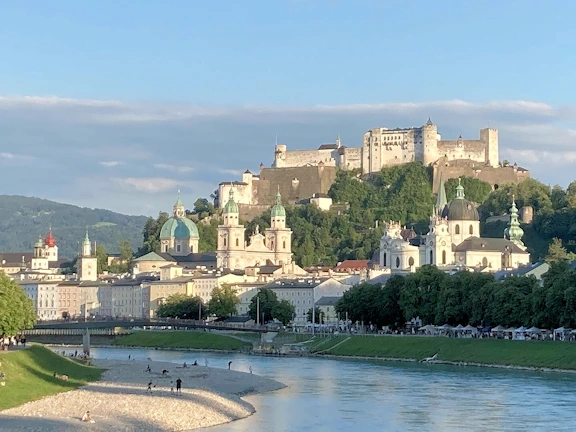
This is the view of the Festung from the Salzburg city side of the Salzach River.
NOTE: This image is the property of Mattsjc via Wikimedia Commons.
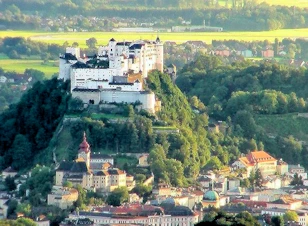
This is the Festung Hohensalzburg, a magnificent example of a fortress originally built by a Catholic Archbishop starting in 1077. This view of the Fortress is from the eastern side, and you can see "old Salzburg" at the foot of the Festung's mountain. It might not be easy to discern, but this Festung is one of the largest medieval castles in Europe.
Inside the fortress, a treasure trove of historical artifacts, exhibitions, and museums awaits. The Salzburg Bull, a magnificent organ dating back to 1502, is a highlight for music enthusiasts. The fortress also houses the Fortress Museum, providing insights into medieval life and military history.
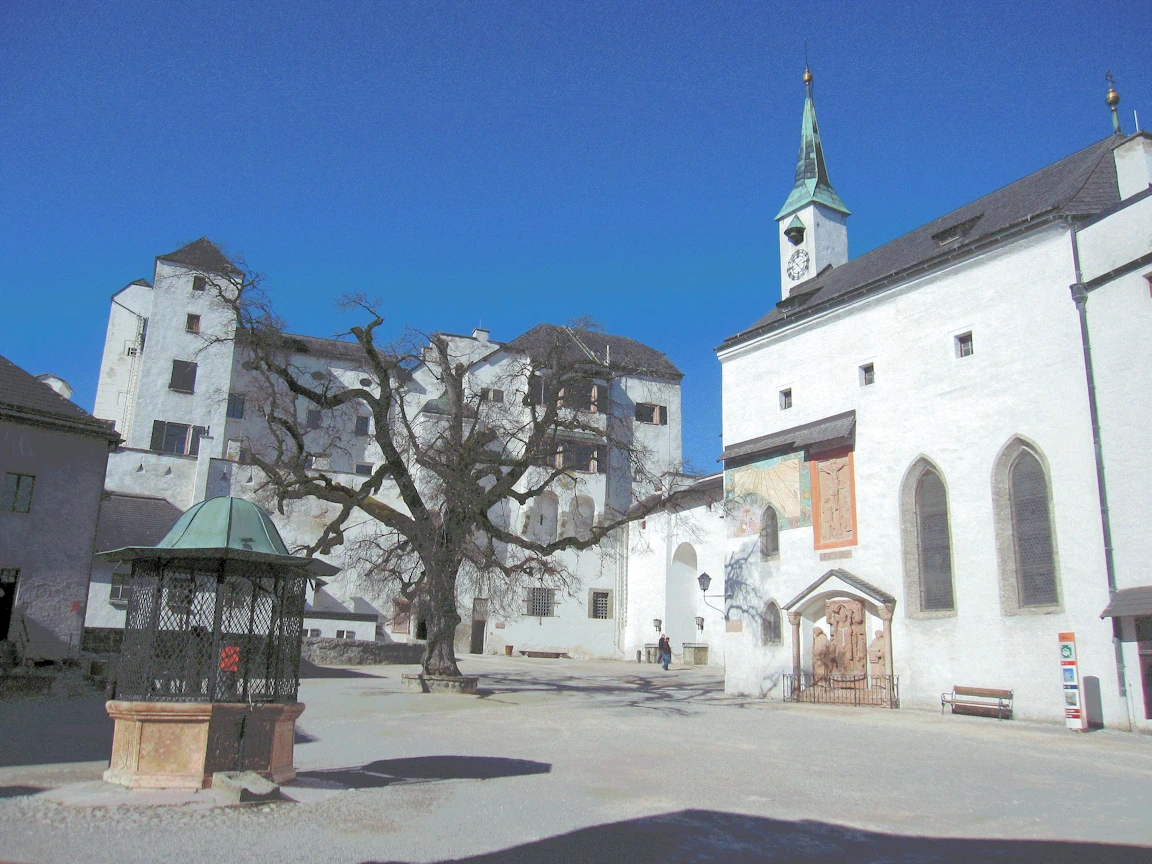
Festung Hohensalzburg inner Courtyard
The fortress consists of various wings and a large courtyard. The Prince-Bishop's apartments are located in the so-called "Hoher Stock" (high floor).
As one steps into this enchanting square, they are transported back in time to the days when this citadel served as a crucial bastion of defense. The inner courtyard is marked by its cobbled pathways, well-maintained gardens, and charming archways. Here, visitors can explore various historical artifacts, learn about the castle's rich history, or simply savor the panoramic views of Salzburg's old town and the surrounding Alpine landscape.
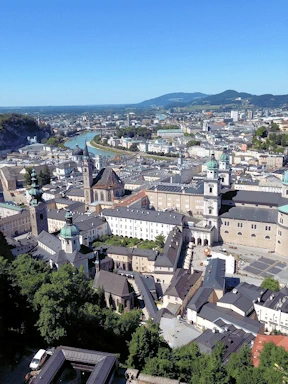
View of Salzburg from the Festung
This is the view from the highest point in the Festung looking east, with the old city below. Gives you some idea of the height of the Festung doesn't it? Google says that the Festung altitude is 506 meters (1,660 feet) and the average elevation of Salzburg is 1,390 feet above sea level.
The church in the center of this image is the Salzburg Cathedral, a seventeenth-century Baroque cathedral of the Roman Catholic Archdiocese of Salzburg.
The River Salzach looks like it is quite far away, but in reality it is only perhaps 1/2 mile away.
Click here to view a very good YouTube Video of the Festung. Please note that this video is the property of RIHA Film and we thank them for such a beautiful video.
The palace was built about 1606 on the shore of the Salzach river north of the medieval city walls, at the behest of Prince-Archbishop Wolf Dietrich Raitenau and it was initially named Schloss Altenau.it is a Baroque masterpiece renowned for its enchanting gardens and cultural significance. The palace exudes grandeur and elegance, featuring ornate architecture and exquisite frescoes. The highlight of Mirabell Palace is its stunning gardens, which include manicured lawns, vibrant flower beds, and impressive sculptures. The Gardens of Mirabell are a UNESCO World Heritage Site and offer breathtaking views of Hohensalzburg Fortress and the Salzach River. The palace itself hosts weddings, concerts, and other events, adding to its allure. Mirabell Palace stands as a testament to Salzburg's rich history and architectural splendor.
Parking in Salzburg during tourist season is always a challenge, but we found the CONTIPARK Tiefgarage Mirabell-Congress-Garage underground parking lot near the Mirabell Palace. We had to walk through the palace grounds on our way to the "old city" on the western side of the Salzach River, which was only a few kilometers away.
Above image is the property of: Andrew Bossi via Wikipedia Commons using the CC BY-SA 2.5 license.
There is our goal, all we have to do is walk through the Palace grounds, cross over the Salzach River on the Karolinen Brücke and wind our way through Old Town.
Mirabell Palace was built in 1606 by the Prince-Archbishop Wolf Dietrich von Raitenau as a symbol of his love for his mistress, Salome Alt. The palace underwent significant renovations in the 18th century and was later used by the royalty of the city.
The Palace is a popular tourist attraction, known for its stunning architecture, intricate detailing, and beautiful gardens. The palace is surrounded by beautifully manicured gardens that feature a wide variety of flowers, plants, and sculptures. The most famous part of the gardens is the Pegasus Fountain, which is considered to be one of the most beautiful fountains in Europe.
The Mozart Square Salzburg (AKA "Mozartplatz") is a rectangular square in the Altstadt (the "old town" of Salzburg), which was created by the demolition of various town houses under Wolf Dietrich von Raitenau in 1588. The square is named after Wolfgang Amadeus Mozart, the famous classical composer who was born and raised in Salzburg.
At the center of Mozart Square is a statue of Mozart, which was erected in 1842 to commemorate the composer's life and legacy. The statue stands tall and proud, overlooking the square and serving as a symbol of the city's deep connection to classical music.
Surrounding the square are numerous cafes, restaurants, and shops, where visitors can enjoy traditional Austrian cuisine and purchase souvenirs to take home. The buildings in the area are well-preserved, showcasing the city's charming architecture and historical significance.
If you are walking from the Karolinen to the Festung, you will most likely walk through or past this area. The Festungsgasse will bring you past the plaza to the Festung entrance in about 10 minutes of walking.
If you are walking along the Festungsgasse, you are going to walk past the southern side of the Cathedral. This seventeenth-century Baroque cathedral is dedicated to Saint Rupert and Saint Vergilius. Saint Rupert founded the church in 774 on the remnants of a Roman town, the cathedral was rebuilt in 1181 after a fire. In the seventeenth century, the cathedral was completely rebuilt in the Baroque style under Prince-Bishop Wolf Dietrich von Raitenau to its present appearance. Salzburg Cathedral still contains the baptismal font in which composer Wolfgang Amadeus Mozart was baptized.
Image # 1: After walking around the Festung, as well as old Salzburg, and since the European heat wave was still in effect, we found an outdoor cafe and had some cold drinks before going back to pick up our Renault, to head back to Munich.
This was at the Café Glockenspiel. It is a traditional coffee house nestled in the heart of Salzburg's old town, situated directly on Mozartplatz with a lovely outdoor garden and views of the Fortress Hohensalzburg. This charming café, which received its typical Viennese coffee house character in 1979, offers a cozy and inviting atmosphere where patrons can enjoy hearty breakfast options, a variety of coffees and teas, sweet strudels, and other delicious pastries. Its prime location makes it an ideal spot for people-watching and enjoying a quintessential Salzburg dining , especially during a mid-morning coffee break or an afternoon treat.
Image # 2: Can there possibly be anything as refreshing as an iced coffee on a hot day?
On 8 August 2013 Temperatures in Austria exceeded 40 degrees Celsius (104 degrees fahrenheit) for the first time since temperature records were recorded. Click here to read a Washington Post article about the heat wave in 2013 (while we were there...).
Located on the eastern side of the Austrian A-10 (51.2 kilometers) south of Salzburg & east of Werfen, are the Eisreisenwelt Ice Caves. Discovered in 1897 and for 35 years, the cave was only reachable by foot. A cable car was constructed in 1955 for the steepest part of the trail (from 1,086 meters to 1,586 meters). In 2015 a new cable car system was installed.
The Eisriesenwelt Ice Cave in Austria is a natural wonder and one of the largest ice caves in the world, attracting over 200,000 visitors from around the world each year. Located near Werfen in the Austrian Alps, this mesmerizing labyrinth stretches over 42 kilometers, showcasing spectacular ice formations, stalactites, and stalagmites. Guided tours lead visitors through a portion of the cave's icy chambers, offering a surreal experience of subterranean beauty. The cave remains naturally cold year-round, making it a refreshing escape during summer months.
The cave is remarkably cold, with interior temperatures hovering around 0°C (32°F) even during summer months. This consistent chill is due to the natural insulation of the mountain and the formation of ice through melted snow seeping into the cave and refreezing. Visitors should dress warmly, wearing winter jackets, long pants, gloves, and sturdy, closed-toe shoes to stay comfortable while exploring this icy marvel.
Salzburg is one of Europe’s most accessible and rewarding cities to explore, offering a seamless mix of historic charm, music heritage, and scenic Alpine backdrops. Here’s how to plan a smooth and memorable trip:
By Air:
Salzburg has a small local airport (SZG), but the easiest international options are Vienna International Airport (VIE) and Munich Airport (MUC).
Once in either Munich or Vienna, you would either need to rent a vehicle or take a train to Salzburg - more info below.
By Train:
Salzburg sits on Austria’s main east–west rail line, with direct connections from Munich, Vienna, Innsbruck, Zurich, and Budapest.
From Vienna (VIE): A new direct train connection now links Vienna Airport to the Salzburg Hauptbahnhof, eliminating the need to transfer in the city. The trip takes about 3 hours on ÖBB (Austrian Federal Railways) Railjet trains.
From Munich (MUC): Frequent regional trains and FlixBus routes reach Salzburg in roughly 2 hours. Deutsche Bahn (DB) operates the high-speed Intercity-Express (ICE) and Intercity (IC) trains on this route.
By Car:
From Munich: The most direct driving route from Munich to Salzburg is a 1.5- to 2-hour trip via the A8 Autobahn, which requires purchasing an Austrian vignette for the Austrian section of the motorway before crossing the border.
From Vienna: The A1 motorway is the most direct driving route from Vienna to Salzburg, taking approximately three hours to complete the 156-mile (251 km) journey.
Parking in Salzburg Navigating parking in Salzburg is challenging, especially in the city center, due to a combination of high costs, limited availability, and ongoing construction. The historic core is largely a pedestrian zone, meaning drivers must contend with underground garages that are often full and expensive. The best solution is to drive there early in the morning and have a parking solution in mind.
Here is a link to a Google Map that displays parking locations in Salzburg.
The compact Old Town (Altstadt) can only be explored on foot, because the Old Town of Salzburg is a pedestrian zone, with access restricted to cars by retractable bollards.
City buses and trolleybuses cover longer routes, and a Salzburg Card provides unlimited transit plus free entry to top attractions like Hohensalzburg Fortress, Mozart’s Birthplace, and Hellbrunn Palace.he compact Old Town (Altstadt) is best explored on foot.
Spring and early autumn offer pleasant weather and lighter crowds.
Summer (July–August) is peak festival season—ideal for music lovers but expect higher hotel rates.
December brings the city’s magical Christmas markets and festive lights.
Stay within or near the Altstadt for walkable access to major sights.
The Neustadt area offers modern hotels and easy rail access.
Consider boutique guesthouses along the Salzach River for charm and convenience.
The Salzburg Card can quickly pay for itself if you visit multiple attractions.
Austria uses the euro (€); credit cards are widely accepted, but small cash payments are still common in cafés and markets.
Bring comfortable walking shoes—many streets are cobblestoned and hilly.
The funicular to the fortress (Festung Hohensalzburg) cost is included in the entrance ticket price. Tickets can be purchased online at their website.
Popular sites like Mirabell Gardens and Hohensalzburg Fortress can become very crowded, especially with day tours arriving around 10:00 a.m.
Hallstatt, a UNESCO World Heritage site, this famously picturesque lakeside village is nestled in the Austrian Alps. You can explore the old town, take a boat tour on Lake Hallstatt, or ride the funicular to the Skywalk for panoramic views.
The Hallein Salt Mine is on the Dürrnberg plateau above Hallein, just a short distance south of Salzburg. It is actually closer to the city than the one in Berchtesgaden, making it a very convenient choice.
Werfen Ice Caves (Eisriesenwelt): Journey to the world's largest ice cave system, located high in the mountains near Werfen. The trip includes a scenic cable car ride and a guided tour of the cave's dramatic ice formations.
The Salzkammergut Lake District: This is the scenic region that surrounds Salzburg, offering stunning Alpine views, charming villages, and sparkling lakes. Popular stops include St. Gilgen and St. Wolfgang on Lake Wolfgang (Wolfgangsee), which can be reached via a historic cog railway.
Berchtesgaden and the Eagle's Nest: Cross into Germany for a trip to the scenic Bavarian Alps. You can visit the Eagle's Nest (Kehlsteinhaus), a former mountain retreat that now offers breathtaking panoramic views. A special bus and elevator take visitors up to the building.
There are some good hikes in the Salzburg area, take a look at this link to the AllTrails website where you will be able to find information including hiker commentary, maps, etc.
Top sights include the Hohensalzburg Fortress, Mozart's Birthplace (Mozarts Geburtshaus), Mirabell Palace and Gardens, and the Salzburg Cathedral.
For mild weather and fewer crowds, spring (April to June) and fall (September to November) are ideal. Summer offers numerous festivals but is the busiest season, while winter is magical for snow sports and Christmas markets.
Yes, Salzburg is largely wheelchair friendly with accessible attractions, accommodations, and public transport, though challenges exist, including steep areas like the Hohensalzburg Fortress and some cobblestones in the Old Town. The city offers barrier-free tours, accessible hotels, and a public transportation system that accommodates wheelchairs. You may need to use alternative transportation like the mountain lift for the fortress and be aware of limited accessible bathrooms in the historic areas.
Salzburg can be pricey, especially during the summer festival season. However, there are budget-friendly activities, and prices are comparable to other major European cities.
Yes, Austria has a low crime rate, and Salzburg is considered a very safe city for tourists and solo travelers. Still, standard safety precautions should be taken, particularly in crowded areas.
The city offers a variety of cuisines, but traditional Austrian food is a highlight. Look for local dishes like Wiener Schnitzel, Sachertorte, and the meringue-like dessert Salzburger Nockerl.
Yes, parking can be difficult in central Salzburg due to limited space, narrow streets, and traffic congestion, though parking garages are available at a higher cost. To make it easier, consider using Park+Ride (P+R) facilities located at the edge of the city, such as at the Messe Centre or airport, and then taking public transport into the historic center.
The most popular and prestigious local beer brand in Salzburg is Stiegl, a brewery founded in 1492 known for its Goldbräu Märzen and Helles lagers. Other well-known local breweries include Augustiner Bräu, which is famous for its Märzen, and Die Weisse. You can also find craft beers from breweries like Hofbräu Kaltenhausen and Bevog, which has a strong reputation for bold, well-crafted beers.
SENNS.Restaurant: A fine dining restaurant from Michelin-starred chef
Andreas Senn, featuring an open kitchen and creative, multi-course menus that emphasize local
ingredients. The contemporary setting offers an avant-garde culinary experience with outstanding and
often experimental dishes.
Google Rating 4.8
Restaurant Brunnauer: A refined choice for modern cuisine that has
received recognition for its fine dining, without being overly formal. The menu highlights seasonal
and local ingredients, and the restaurant features outdoor seating for an enhanced experience.
Google Rating 4.8
Esszimmer: This restaurant provides a relaxed and informal setting
for its contemporary Austrian tasting menus. Despite its Michelin star, the atmosphere is cozy,
featuring dishes with creative combinations and beautiful presentations.
Google Rating 4.8
IMLAUER Sky - Bar & Restaurant in Salzburgszimmer: This rooftop restaurant
is praised for its view of the Salzburg skyline, especially of the Hohensalzburg Fortress. The menu
features a mix of traditional Austrian classics and Mediterranean cuisine, and the terrace is a
sought-after seating area.
Google Rating 4.6
Bärenwirt: For a classic and authentic Austrian tavern
experience, this is a highly-rated option. It is known for its fried chicken, bread
dumplings, and traditional beer, served in a woodsy, old-world setting with an
outdoor terrace.
Google Rating 4.5
Note: All images featured on this page are the exclusive property of Just Traveling Thru, LLC, unless otherwise stated. When images from external sources are used, full credit is given to the original creator, along with a link to the specified license or usage terms. We are committed to respecting copyright and intellectual property rights, ensuring that all third-party images are properly attributed. If you have any questions regarding image ownership or usage rights, please feel free to contact us.
Affiliate Links: We may earn a commission if you make a purchase through one of our affiliate links. This helps support our travel content — thank you!
Content: To review any of our content, make suggestions and/or comments, please click the "About" menu link at the top of this page. You will find our "Contact Us" link on that drop-down menu.